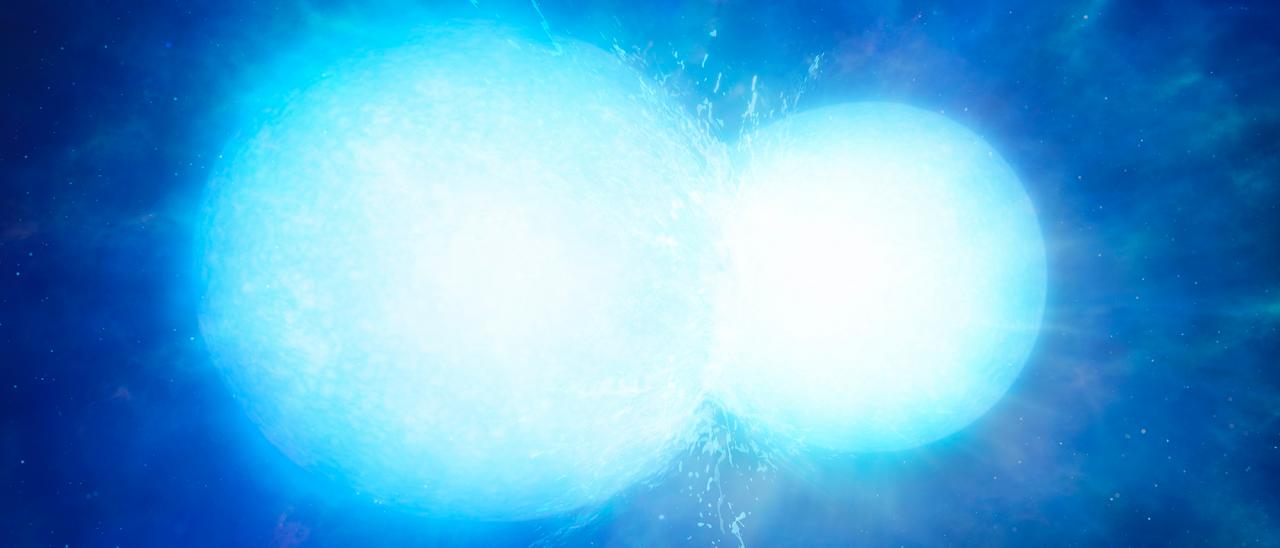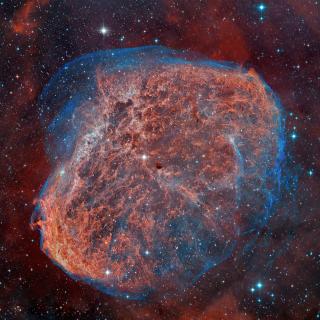An international team of researchers led by the University of Warwick, with a member who is a scientist at the IAC has discovered white dwarf with unusual dimensions. This star could be, in fact, the result of the merger of two white dwarfs. The discovery is published today in the journal Nature Astronomy, and could resolve some questions about the evolution of white dwarfs, and about the number of supernova in our Galaxy.
The star, which is 150 light years away, was identified by data from the satellite telescope GAIA of the European Space Agency (ESA). Based on these, the astronomers used the William Herschel Telescope (WHT) of the Isaac Newton Group of Telescopes (ING) at the Roque de los Muchachos Observatory (Garafía, La Palma), to observe possible white dwarfs with unusually large dimensions. They used spectroscoph to analyse the chemical composition of its atmosphere, and to find high levels of carbon there, in itself unusual.
The first author on the paper, Mark Hollands, of the Physics Department, University of Warwick (England), comments “This star stood out because it was different from anything previously seen. We normally expecto to find an external layer of hydrogen, sometimes mixed with helium, or just a combination of helium and carbon. You don’t expect to find hidrogen and carbon together, because there should be a thick layer of helium between them to prevent this. When we observed this, it didn’t make sense”.
To try to solve the mystery, the scientists investigated the origin of the star. White dwarfs are the remains of stars like the Sun which have used up all their fuel and have expelled their outer layers. The majority are rather light, (some 0.6 times the mass of the Sun) but this white dwarf has almost twice the mass. Even so, the star has a diameter only two thirds that of the Earth, that is 150 times smaller than the Sun.
The age of the white dwarf was another clue that the researchers followed. “The oldest stars orbit the Milky Way more quickly than the younger ones. This object moved more quickly than 99% of the other white dwarfs of around the same age”, explains Paula Izquierdo, an IAC researcher an a co-author of the article. “This suggests that the star must be older than it looks”.
“We cannot explain its composition” adds Hollands “by normal stellar evolution, it has a mass twice that expected for a white dwarf, and a kinematic age greater than inferred by its cooling. We are sure that, as a single white dwarf shouldn`t behave like that, the only way to explain it is if it were formed by the merger of two white dwarfs”.
When a star in a binary system expands, towards the end of its life, it can form an envelope around its companion, and the orbits bring them closer as the first star shrinks. The same can occur when the other star expands. During thousands of millions of years, gravitational radiation will shrink the orbits, until the point at which the two stars merge.
Although the merger of dwarf stars has been predicted, this one in particular is unusual. The majority of the mergers in our Galaxy occur between stars with different masses, while this one seems to have occurred between two stars with similar mass. There is also a physical limit to the mass of the resulting white dwarf; if it is higher than 1.4 solar masses we think that it will explode as a supernova, although it is possible that these explosions occur at somewhat lower masses. So the discovery of this star is useful to show just how massive a white dwarf can be, and still survive.
Because the merger reinitiates the cooling of the star, it is difficult to determine its age. This white dwarf probably was formed by a merger 1.3 thousand million years ago, but the two original white dwarfs could have existed thousands of millions of years earlier.
“Perhaps the most exciting thing about this star–concludes Hollands– is that it must have failed to explode as a supernova –those giant explosions are very important to map the structure of the universe, because they can be detected at great distances. Nevertheless, there is still considerable uncertainty about what type of stellar systems do reach the supernova phase. Although it sounds strange to measure the properties of this “failed” supernova, and similar ones in the future, it tells us a lot about the routes to thermonuclear self-destruction”.
Article: Hollands, M. et al. “Two stars merged to form massive white dwarf”, Nature Astronomy, March 2, 2020, DOI: 10.1038/s41550-020-1028-0
ING Group press release: http://www.ing.iac.es/PR/press/ultraWD.html
Contact:
Paula Izquierdo, IAC researcher: paula.izquierdo [at] iac.es (paula[dot]izquierdo[at]iac[dot]es)



